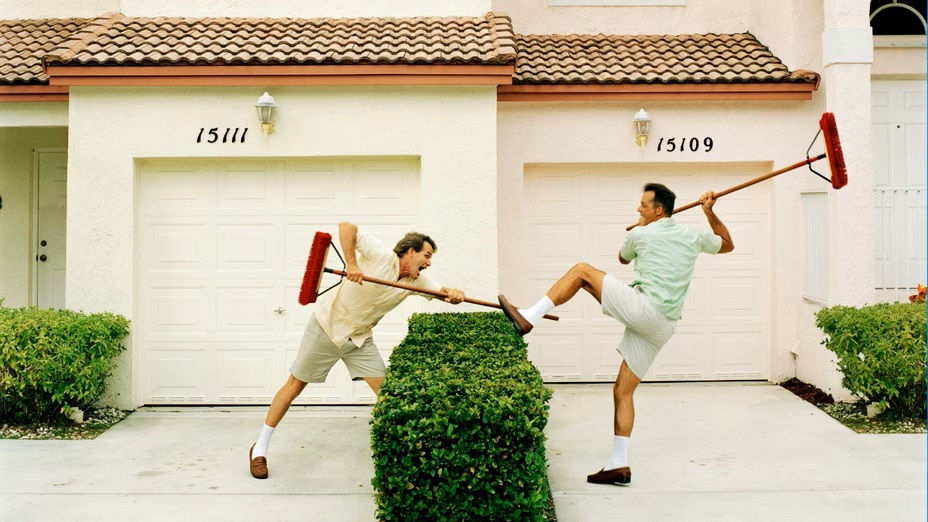VMM counsel Thomas Weiss, a member of the firm’s Real Estate Litigation, Commercial Litigation, and Matrimonial & Family Law practices and head of the Bankruptcy practice, is interviewed in Realtor.com about property encroachment and boundary disputes between neighbors.
In can be read online here and below.
Neighbors Crossing the (Property) Line: What Can You Do About Encroachments After They Happen
By Allaire Conte
May 12, 2025

You’ve heard about nosy neighbors, but what about encroaching ones?
When a neighbor’s fence, tree, driveway, or even a garage starts creeping onto your property, it’s more than just an eyesore. It’s called a property encroachment, and it can lead to costly legal disputes, stalled home sales, or loss of land rights if left unaddressed.
Whether you’re spotting your neighbor’s new shed creeping over the line or reviewing a survey before selling your home, we’ll walk you through how to verify an encroachment, what legal and informal steps you can take to resolve it, and how to protect your property rights—without losing your cool (or your yard).
What is property encroachment?
Property encroachment occurs when a structure or physical object crosses onto your land without permission.
“Technically, any physical feature (from a building extension to landscaping) that crosses the legal boundary line is an encroachment if it's on your property without your permission,” says Alexei Morgado, a real estate agent in Florida and CEO and founder of Lexawise Real Estate Exam Prep.
Common types of encroachment include the following:
Fences
Walls
Sheds
Tree limbs
Driveways
Structural overhangs
Garden extensions
Encroachments are often unintentional, caused by misunderstandings about where a property line begins and ends, but they can still lead to major legal and financial headaches if left unaddressed.
How to tell if a neighbor is crossing your property line
That fence might look like it’s over the line, but don’t act on a hunch. First, confirm your exact property boundaries.
Start by checking your deed and the plat or survey you received when you bought the home. County land records or GIS mapping tools might also help.
But be prepared to call in a professional, says Thomas Weiss, real estate litigation attorney at Vishnick McGovern Milizio LLP.
“A homeowner who believes that a neighbor has erected a fence, shed, driveway, or some other encroaching structure onto their property should first make sure they have a current survey.”
A survey is a legal document, usually a map, that shows the precise boundaries and dimensions of your land. It’s typically prepared by a licensed surveyor and might also mark structures, easements, and setbacks.
Having one in hand can serve as legal proof of encroachment if you need to take action later on.
What to do when you discover an encroachment
You have the proof, now here’s how to deal with an encroachment.
Step 1: Start with a friendly conversation
Before jumping into legal action, try resolving the issue directly, advises Morgado.
“It's generally best to start by having a friendly, direct conversation. Go straight to your neighbor and present them with the survey or plat, and state your issue, since many encroachments are innocent and can be quickly fixed that way.”
Unintended encroachments are more common than you might think. After all, property lines aren’t marked like yard lines on a football field. When boundaries get blurred, a simple conversation is often all it takes to clear things up.
Step 2: Send a formal letter
If a friendly conversation doesn’t resolve the issue, it may be time to put things in writing. A formal letter can serve as an official notice to your neighbor and create a paper trail in case the matter escalates.
“The second resort would be drafting a formal letter (if practicable, through an attorney) placing the neighbor on notice of the encroachment, citing the boundary crossing, and demanding a solution within a specified date,” says Morgado.
Step 3: Take legal action if necessary
If you’re still unable to come to an agreement with your neighbor, you might need to take legal action.
“The aggrieved party may bring legal action to force the encroaching neighbor to remove the encroachment,” says Weiss. “Common causes of action in such cases are requests for injunctive relief seeking to compel the removal of the encroaching structure and trespass.”
But be prepared to make a case. For example, “Under New York law, the plaintiff must prove that the encroachment was not de minimus, which is to say generally that the encroachment is greater than one foot in length,” explains Weiss.
Laws vary by state, so be sure to consult a local real estate attorney to understand how precedent might apply in your jurisdiction.
Alternative solutions
If legal action isn’t practical, or desirable, you may want to consider a more flexible approach. In some cases, it makes sense to formally allow the encroachment to remain.
“You can give consent formally for the encroachment in an easement agreement or a revocable license and grant the neighbor the right to continue encroaching but maintaining your ownership (avoiding an adverse possession claim),” says Morgado.
These agreements preserve your property rights while preventing future disputes—and might be faster and less costly than litigation.
Will title insurance help in an encroachment dispute?
Title insurance can help in some encroachment cases, but don’t assume it’s a catch-all, explains Weiss.
“Title insurance is helpful if the title company insured the property without accounting for existing encroachments,” he says. “A title company will require a valid current survey, so if the encroachment is accounted for in the survey, it would typically be omitted from the coverage.”
In other words, if the encroachment was visible or recorded in the survey at closing, it’s likely excluded. If it wasn’t—and your policy includes extended coverage—it might be covered.
What happens if you want to sell a property with an encroachment?
Trying to sell a home with an encroachment issue? Prepare for complications.
“Sellers are legally required in most states to disclose any known encroachments or boundary issues on the property to prospective buyers,” says Morgado.
Even if it’s not known, it’s likely to come up. Buyers—and their lenders—typically require a survey before closing. If an encroachment is discovered, it can derail financing, delay the deal, or force last-minute negotiations.
Most buyers will want the issue resolved before moving forward. If not addressed, the encroachment can reduce your pool of interested buyers and your sale price.
In some cases, the neighbor might even claim adverse possession, creating long-term legal headaches that few buyers are willing to take on.
“The neighbor may have a claim of adverse possession, which may become permanent,” Weiss adds. “In that case, the encroached-upon property is less valuable.”
Tips for homeowners dealing with encroachments
If you suspect—or confirm—an encroachment on your property, don’t wait to act. A proactive, informed approach can save you time, money, and legal stress.
“Keep detailed records of all communications and agreements related to encroachments,” says Weiss. “Consult with real estate attorneys or surveyors to understand your rights and options, [and] address encroachments promptly to prevent legal complications or loss of property rights.”
Allaire Conte is a senior advice writer covering real estate and personal finance trends. She previously served as deputy editor of home services at CNN Underscored Money and was a lead writer at Orchard, where she simplified complex real estate topics for everyday readers. She holds an MFA in Nonfiction Writing from Columbia University and a BFA in Writing, Literature, and Publishing from Emerson College. When she’s not writing about homeownership hurdles and housing market shifts, she’s biking around Brooklyn or baking cakes for her friends.



